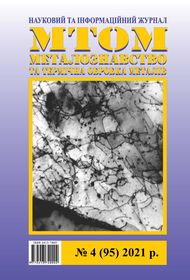ANALYSIS OF SPECIFIC FEATURES OF THE FORMATION OF STRUCTURAL INHOMOGENEITY OF CARBON STEEL (REVIEW)
DOI:
https://doi.org/10.30838/J.PMHTM.2413.281221.18.821Keywords:
carbon steel; dendritic liquation; non-metallic inclusions; diffusion; crystallization; deformation; rolling; structural inheritanceAbstract
Purpose. To consider possible factors of influence on the formation of structural and grain unevenness of carbon steel. Methodology. Based on the analysis of the existing literature, the influence of various factors on the structural heterogeneity in carbon steels is analyzed. Results. From the analysis of the literature, a number of reasons were identified that affect the formation of heterogeneity in the structure of carbon steels. These factors include: chemical composition, dendritic liquation and processing liquation, non-metallic inclusions, mechanisms of austenite grain formation, initial grain size, and steel contamination with gases. Scientific novelty. On the part of the chemical composition, chemical elements such as carbon, copper, aluminum, silicon, nitrogen, sulfur and phosphorus affect the liquation formation. The formation of the microliquation level is also significantly influenced by the type of the formed structure. It has been shown that the level of segregation with directional crystallization is much higher than with equilibrium crystallization. Also, the formation of the final structure is associated with a hereditary influence in the production of metal products of the structural features of the parent metal, which depend on various technological factors. The contribution of certain metallogenetic signs of technological heredity occurs at all stages of melting, crystallization, structure formation, solid-phase transformations; different types of thermal, deformation-thermal, deformation processing, etc. In most cases, it is technological factors that are responsible for the structural features and manifestations of the metallurgical and structural heredity of metals and alloys. The dispersion of the dendritic structure, which grows with an increase in the crystallization rate, has a significant effect on the development of dendritic segregation in the ingot. With an increase in the dispersion of the dendritic structure, the total crystallization surface grows and a significant part of the liquid metal solidifies at higher temperatures. Practical significance. As a result of the performed review of the literature, the main factors influencing the formation of the final structural and grain unevenness were determined in accordance with modern points of view. Determination of the basic principles and the most effective factors will make it possible to confidently assume the possible microstructure of steel both in the cast state and after heat treatment.

Downloads
Published
Issue
Section
License
Authors that are published in this journal agree to follow the conditions:
Authors reserve the right to the authorship of his work and cede the right to the journal of first publication of this work on conditions of the license under the Creative Commons Attribution License, which allows others to distribute it freely with the obligatory reference to the author of the original work and the first publication of the work in this journal.
